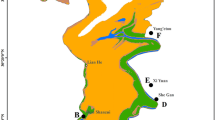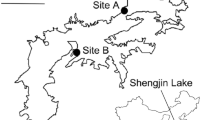Abstract
Microhabitat variables are determinants for animals to select forage patches and evaluate the cost/benefit tradeoffs of habitat switching. Optimal foragers would weigh habitat quality by giving-up net energy intake rate (GUN), which includes the energy intake rate and cost rate. The GUNs, energy intake rate, and cost rate can be influenced by variations in different microhabitat factors and interactive effects. In this study, we assessed the GUN patterns of wintering Bewick’s swans and the effects of microhabitat factors on their foraging strategy in three different habitats: foxnut ponds, paddy fields, and shallow lake. The foraging behaviors and microhabitat variables of the swans were investigated during the winters of 2016–2018 and 2017/2018 at Huangpi and Shengjin Lakes in Anhui Province, southeastern China. The results showed that the percentage of disturbance time and the giving-up food density in shallow water had significant negative effects on GUNs. In contrast, water depth and the giving-up food density in deep water showed positive effects on GUNs. GUNs were significantly different among the three habitats. GUNs also decreased as winter progressed. Swans would decrease their GUNs under unfavorable foraging conditions such as more disturbances; however, GUNs would increase with water depth and food availability in patches with deep water. The swans demonstrated diverse GUN patterns in different foraging habitats, driven by the tradeoffs between energy intake rates and energy cost rates that were influenced by microhabitat variables. It implies that waterbirds exposed to decreasing GUNs may mitigate energy demand and environmental stress by switching foraging habitat while in subprime foraging habitat if alternative habitats that offered higher net rates of energy gain were available.


Similar content being viewed by others
References
Altmann J (1974) Observational study of behavior: sampling methods. Behaviour 49:227–266
Bartoń K (2015) MuMIn: multi-model inference. R Package version 1.40.4. Available at https://cran.r-project.org/web/packages/MuMIn
Béchet A, Giroux JF, Gauthier G (2004) The effects of disturbance on behaviour, habitat use and energy of spring staging snow geese. J Appl Ecol 41:689–700. https://doi.org/10.1111/j.0021-8901.2004.00928.x
Beekman JH, van Eerden MR, Dirksen S (1991) Bewick’s swans (Cygnus columbianus bewickii) utilising the changing resource of Potamogeton pectinatus during autumn in the Netherlands. Wildfowl Supplement 1:238–248
Beekman J, Koffijberg K, Wahl J et al (2019) Long-term population trends and shifts in distribution of Bewick’s swans Cygnus columbianus bewickii wintering in Northwest Europe. Wildfowl, Special Issue 5:73–102
Belanger L, Bedard J (1989) Responses of staging greater snow geese to human disturbance. J Wildl Manag 53(3):713–719. https://doi.org/10.2307/3809202
Bhatt B, Gupta V, Kumar L, Singh IS, Sarkar B (2007) Euryale ferox (Salisb): promising aquatic food crop of Eastern Indo Gangetic Plains. International Journal of Current Microbiology and Applied Sciences 6(6):1914–1921. https://doi.org/10.20546/ijcmas.2017.606.223
Brown JS (1988) Patch use as an indicator of habitat preference, predation risk, and competition. Behav Ecol Sociobiol 22(1):37–47. https://doi.org/10.1007/BF00395696
Brown JS (1999) Vigilance, patch use and habitat selection: foraging under predation risk. Evol Ecol Res 1:49–71
Brown JS, Kotler BP (2004) Hazardous duty pay and the foraging cost of predation. Ecology Letters 7(10):999–1014. https://doi.org/10.1111/j.1461-0248.2004.00661.x
Charnov EL (1976) Optimal foraging, the marginal value theorem. Theor Popul Biol 9(2):129–136. https://doi.org/10.1016/0040-5809(76)90040-X
Chen J, Zhou L, Zhou B, Xu R, Zhu W, Xu W (2011) Seasonal dynamics of wintering waterbirds in two shallow lakes along Yangtze River in Anhui Province. Zool Res 32(5):540–548. https://doi.org/10.3724/SP.J.1141.2011.05540
Clausen KK, Madsen J, Nolet BA, Haugaard L (2018) Maize stubble as foraging habitat for wintering geese and swans in northern Europe. Agr Ecosyst and Environ 259:72–76
Cong P, Cao L, Fox AD (2011) Changes in tundra swan (Cygnus columbianus bewickii) distribution and abundance in the Yangtze River floodplain. Bird Conservation International 21(3):260–265. https://doi.org/10.1017/S0959270911000098
Fox AD, Madsen J (1997) Behavioural and distributional effects of hunting disturbance on waterbirds in Europe: implications for refuge design. The Journal of Applied Ecology 34(1):1–13. https://doi.org/10.2307/2404842
Fox AD, Cao L, Zhang Y, Barter M, Zhao MJ, Meng FJ, Wang SL (2011) Declines in the tuber-feeding waterbird guild at Shengjin Lake National Nature Reserve, China-a barometer of submerged macrophyte collapse. Aquat Conserv Mar Freshwat Ecosyst 21(1):82–91. https://doi.org/10.1002/aqc.1154
Gawlik DE (2002) The effects of prey availability on the numerical response of wading birds. Ecol Monogr 72(3):329–346. https://doi.org/10.1890/0012-9615(2002)072[0329:TEOPAO]2.0.CO;2
Gyimesi A, Franken MS, Feige N, Nolet BA (2012) Human disturbance of Bewick’s swans is reflected in giving-up net energy intake rate, but not in giving-up food density. Ibis 154:781–790. https://doi.org/10.1111/j.1474-919X.2012.01253.x
Jiao S (2015) Habitat selection and foraging strategy of hooded crane on migration route in China. Beijing Forestry University, Doctoral Dissertation, China
Johnstone I, Norris K (2000) The influence of sediment type on the aggregative response of oystercatchers, Haematopus ostralegus, searching for cockles, Cerastoderma edule. Oikos 89(1):146–154. https://doi.org/10.1034/j.1600-0706.2000.890116.x
King S, Elphick CS, Guadagnin D, Taft O, Amano T (2010) Effects of landscape features on waterbird use of rice fields. Waterbirds 33(2):151–159. https://doi.org/10.1675/063.033.s111
Kraan C, van Gils JA, Spaans B, Dekinga A, Bijleveld AI, van Roomen M, Kleefstra R, Piersma T (2009) Landscape-scale experiment demonstrates that Wadden Sea intertidal flats are used to capacity by molluscivore migrant shorebirds. J Anim Ecol 78:1259–1268. https://doi.org/10.1111/j.1365-2656.2009.01564.x
Krebs JR, Kacelnik A, Taylor P (1978) Test of optimal sampling by foraging great tits. Nature 275(5675):27–31. https://doi.org/10.1038/275027a0
Leeuw JJD, van Eerden MR, Visser GH (1999) Wintering tufted ducks (Aythya fuligula) diving for zebra mussels (Dreissena polymorpha) balance feeding costs within narrow margins of their daily energy budget. J Avian Biol 30(2):182–192. https://doi.org/10.2307/3677128
Lovvorn JR (1996) A spatial energetics model of cadmium accumulation by diving ducks. Arch Environ Contam Toxicol 30(2):241–251. https://doi.org/10.1007/BF00215804
Nolet BA, Drent RH (1998) Bewick’s swans refuelling on pondweed tubers in the Dvina Bay (White Sea) during their spring migration: first come, first served. J Avian Biol 29(4):574–581. https://doi.org/10.2307/3677178
Nolet BA, Klaassen M (2009) Retrodicting patch use by foraging swans in a heterogeneous environment using a set of functional responses. Oikos 118(3):431–439. https://doi.org/10.1111/j.1600-0706.2008.16857.x
Nolet BA, Langevoord O, Bevan RM, Engelaar KR, Klaassen M, Mulder RJW, van Dijk S (2001) Spatial variation in tuber depletion by swans explained by differences in net intake rates. Ecology 82(6):1655–1667. https://doi.org/10.1890/0012-9658(2001)082[1655:SVITDB]2.0.CO;2
Nolet BA, Bevan RM, Klaassen M, Langevoord O, van Der Heijden YGJT (2002) Habitat switching by Bewick’s swans: maximization of average long-term energy gain? J Anim Ecol 71(6):979–993. https://doi.org/10.1046/j.1365-2656.2002.00662.x
Nolet BA, Fuld VN, van Rijswijk MEC (2006) Foraging costs and accessibility as determinants of giving-up densities in a swan-pondweed system. Oikos 112(2):353–362. https://doi.org/10.1111/j.0030-1299.2006.13463.x
Olsson O, Brown JS (2006) The foraging benefits of information and the penalty of ignorance. Oikos 112(2):260–273. https://doi.org/10.1111/j.0030-1299.2006.13548.x
Owen M, Cadbury CJ (1975) The ecology and mortality of swans at the Ouse Washes, England. Wildfowl 26:31–42
Platteeuw M, Henkens RJHG (1997) Possible impacts of disturbance to waterbirds: individuals, carrying capacity and populations. Wildfowl 48:225–236
R Core Team (2017) R: a language and environment for statistical computing. R Foundation for Statistical Computing, Vienna
Schummer ML, Eddleman WR (2003) Effects of disturbance on activity and energy budgets of migrating waterbirds in South-Central Oklahoma. J Wildl Manag 67(4):789–795. https://doi.org/10.2307/3802686
Shuford WD, Reiter ME, Strum KM, Gilbert MM, Hickey CM (2016) The benefits of crops and field management practices to wintering waterbirds in the Sacramento-San Joaquin River Delta of California. Renewable Agriculture and Food Systems 31(6):495–506. https://doi.org/10.1017/S174217051500040X
Smart SL, Stillman RA, Norris KJ (2008) Measuring the functional responses of farmland birds: an example for a declining seed-feeding bunting. J Anim Ecol 77(4):687–695. https://doi.org/10.1111/j.1365-2656.2008.01375.x
Song Y, Zhou L (2019) Effects of habitat changes on spatio-temporal pattern of the wintering waterbrid community at Shengjin Lake. J Anhui Agric Univ 46(4):610–617
Symonds MRE, Moussalli A (2011) A brief guide to model selection, multimodel inference and model averaging in behavioural ecology using Akaike’s information criterion. Behav Ecol Sociobiol 65(1):13–21. https://doi.org/10.1007/s00265-010-1037-6
Systad GH, Bustnes JO, Erikstad KE (2000) Behavioral responses to decreasing day length in wintering sea ducks. Auk 117(1):33–40. https://doi.org/10.1642/0004-8038(2000)117[0033:BRTDDL]2.0.CO;2
Wood KA, Stillman RA, Wheeler D, Groves S, Hambly C, Speakman JR, Daunt F, O’Hare MT (2013) Go with the flow: water velocity regulates herbivore foraging decisions in river catchments. Oikos 122:1720–1729
Wood KA, Hilton GM, Newth JL, Rees EC (2019) Seasonal variation in energy gain explains patterns of resource use by avian herbivores in an agricultural landscape: insights from a mechanistic model. Ecol Model 409:108762
Yu C, Zhou L, Mahtab N, Fan S, Song Y (2019) The influence of food density, flock size, and disturbance on the functional response of Bewick’s swans (Cygnus columbianus bewickii) in wintering habitats. Animals 9:946
Acknowledgments
We thank the people who helped collect the microhabitat data in Shengjin and Huangpi lakes, including Ruilin Zhang, Yiwei Bao, Jinming Zhao, Zhengrong Zhu, and Bin Zhao, to Lei Cheng for statistical assistance, Elena Ilyashenko, Anne Lacy, and Lingying Shuai for their invaluable suggestions and revisions to the original manuscript, and constructive comments of anonymous reviewers. We would like to thank Editage (www.editage.cn) for English language editing.
Funding
This work was supported by the National Natural Science Foundation of China (Grant No. 31472020).
Author information
Authors and Affiliations
Corresponding author
Additional information
Responsible editor: Philippe Garrigues
Publisher’s note
Springer Nature remains neutral with regard to jurisdictional claims in published maps and institutional affiliations.
Rights and permissions
About this article
Cite this article
Yu, C., Zhou, L., Mahtab, N. et al. Microhabitat variables explain patch switching by wintering Bewick’s swans through giving-up net energy intake rates. Environ Sci Pollut Res 27, 18843–18852 (2020). https://doi.org/10.1007/s11356-020-08343-w
Received:
Accepted:
Published:
Issue Date:
DOI: https://doi.org/10.1007/s11356-020-08343-w




